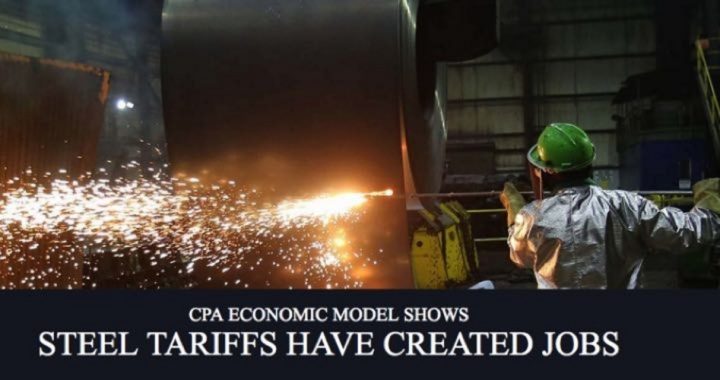
A nonpartisan trade group representing farmers, ranchers, manufacturers, and various labor groups reported on Tuesday that, according to its economic model, Trump’s tariffs on steel “are creating US jobs and stimulating growth,” the opposite of what many mainstream economists predicted.
The Coalition for a Prosperous America (CPA) measured the impact of the steel tariffs on the U.S. economy and found that those “steel tariffs, in combination with other economic policies [implemented by the Trump administration] will drive growth of 2.1 million additional jobs in 2018 … and an additional 1.2 million jobs are expected to be created annually in the years 2019 through 2021.”
Traditional economic models got it wrong, said CPA Research Director Jeff Ferry:
The performance of the US economy since the steel tariff was implemented in March has been outstanding, with over a million more jobs in the US economy today than in March, and GDP growth roughly half a point higher than economists had predicted.
Most trade models got this wrong due to mistaken assumptions about how the economy would react to the tariffs. Our improved economic model corrects some key mistakes in standard economic models and incorporates actual economic results rather than assumptions. The results forecast that the steel tariffs, in combination with other economic policies, will create some 2 million jobs this year, with another million more to come next year.
He backed this up with data from the Federal Reserve’s latest industrial production report showing that U.S. manufacturing output was up 2.7 percent year over year, with strong production increases in steel-using industrials such as machinery (6.9 percent growth) and aerospace (4.0 percent growth). In addition, according to CPA’s metal-using members, Trump’s steel tariffs have also triggered new investment in steel production facilities estimated to approach three billion dollars nationally.
In a theoretically free economy, tariffs are a drag, as they serve as a tax on production, raising prices for finished goods and as a result diminishing demand for those goods. In today’s world, things are vastly different. Tariffs can be used not only to protect domestic industries from attack by outside interests inimical to the country’s best interests, they may be (and have been) used to punish foreign competition, to raise government revenue, and to reduce “undesirable” activity (so-called “sin” taxes on cigarettes and liquor, for example).
In today’s world the communist Chinese regime is using every means at its disposal to damage and weaken the United States. As The New American noted on Tuesday:
That’s why the side meeting in Buenos Aires [this weekend] between Trump and Xi is going to be the main event. It will address existential issues for both countries that go far beyond disputes over intellectual property theft, subsidizing critical industries such as steel and aluminum in order to weaken the United States, and China manipulating its currency to its own advantage.
China has built its military and economic power on the back of the United States ever since it joined the World Trade Organization in late 2001, and has made clear its plans to become the hegemon in East Asia.
In this real world, President Trump is using tariffs, and the threat of increased tariffs, to force the Chinese communists to change their behavior. If he succeeds, and he is able to strike what he calls “a fair deal … [a] deal [that would force] China to open up their country to competition from the United States,” that would approach a miracle. In the real world, word is getting out that the best Trump is likely to get from the Chinese this weekend is an agreement to hold “serious” talks about acceding to some of the 142 trade demands he has already presented to the Chinese in previous meetings.
In a truly free world, economic tariffs wouldn’t exist (or would be applied at a very low level), reducing the price of goods and services across the globe. That’s Trump’s goal.
That is not the goal of the Chinese communists. Gordon Chang, author and frequent guest on the topic, holds that China doesn’t want to just “dominate in advanced industries,” it wants to dominate the world. In an interview on Breitbart News Tonight in March, he said: “China’s not just content with the world as it is; it actually wants to overthrow the international system.”
That’s one more reason why those job gains in the U.S. steel industry are so important. They might just be needed in the event the Chinese communists fail to change their behavior.
Image: Screenshot of prosperousamerica.org
An Ivy League graduate and former investment advisor, Bob is a regular contributor to The New American magazine and blogs frequently at LightFromTheRight.com, primarily on economics and politics. He can be reached at [email protected].
Related articles:
Trump-Xi Showdown in Buenos Aires Begins Friday
Report Confirms That China’s Policy to Weaken the U.S. Is Working



